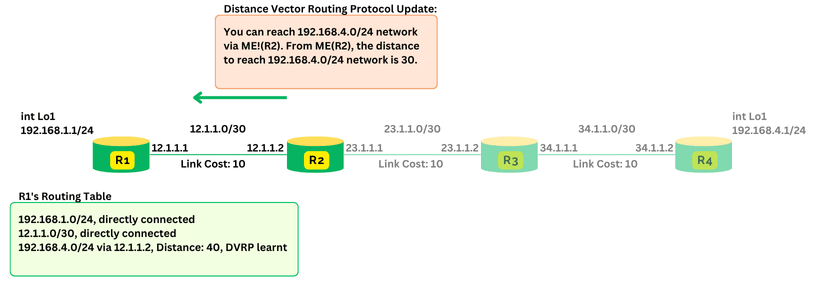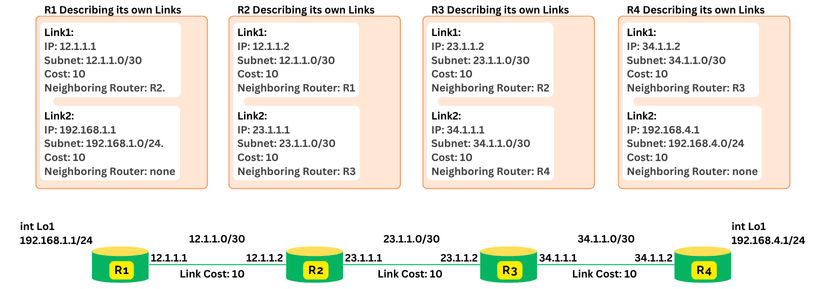What is OSPF?
Table of Contents
OSPF: Core Concepts and Purpose
OSPF, which stands for Open Shortest Path First, is a fundamental dynamic routing protocol. Its primary job is to allow routers within a network to automatically learn about paths to different destination networks and then help the router make intelligent decisions about how to forward data packets to their destinations.
Let's break down what this means:
Dynamic Routing vs. Static Routing
By default, a router only knows about networks that are directly connected to its own interfaces. For instance, if Router R1 has a loopback interface configured with the network 192.168.1.0/24 and a physical interface connected to the 12.1.1.0/30 network, R1 will intrinsically know about these two networks.

However, R1 will not automatically know about a remote network, say 192.168.4.0/24, which might be several hops away, connected to Router R4.
- Static Routing: One way to inform R1 about the
192.168.4.0/24network is through static routing. This involves manually configuring a route on R1, telling it: "To reach192.168.4.0/24, your next-hop IP address is12.1.1.2(the IP address of R2's interface facing R1)." While this works, it requires significant administrative effort, especially in larger networks, and doesn't adapt automatically to network changes. - Dynamic Routing (where OSPF fits in): This is where protocols like OSPF come into play. Instead of manual configuration, routers running OSPF will "talk" to each other. They exchange information about the networks they know. So, R1 can learn about
192.168.4.0/24(and how to reach it) automatically from its OSPF neighbors. This process is dynamic – if a path changes or a new network is added, OSPF routers will update each other.

OSPF as an Interior Gateway Protocol (IGP)
Dynamic routing protocols are broadly categorized:
- Interior Gateway Protocols (IGPs): These are designed to be run within a single organization or "autonomous system." Their primary goal is to find the most efficient (shortest) paths for traffic inside that organization's network. OSPF is a prime example of an IGP.
- IGPs are generally built for speed and quick convergence (adapting to network changes).
- However, they typically cannot handle the massive scale of routes found on the global internet (millions of routes). Their strength lies in managing routing within a controlled administrative domain.
- Exterior Gateway Protocols (EGPs): These are designed for routing between different autonomous systems (e.g., between different companies or Internet Service Providers). The main EGP used today is BGP (Border Gateway Protocol).
- EGPs are built for massive scalability and policy control rather than just raw speed or shortest path.

OSPF is an IGP, meaning its primary domain of operation is within an enterprise or a service provider's internal network.
OSPF as a Link-State Routing Protocol
IGPs themselves are further classified, and OSPF is a link-state protocol. This is crucial:
- Distance Vector Routing Protocols (e.g., RIP):
- These protocols operate on the principle of
"routing by rumor."A router learns about remote networks from its direct neighbors. - Each router tells its neighbors, "I can reach network X, and my distance to it is Y." The neighbor doesn't see the whole map; it just trusts the information from its direct peer.
- They have a limited view of the network topology.
- These protocols operate on the principle of
- Link-State Routing Protocols (OSPF, IS-IS):
- These protocols operate on the principle of
"routing by fact"or"routing by map." - How it works:
- Local Environment Description: Each router running OSPF describes its own connections (links), including their link status like the IP address on the link, the network subnet connected, the OSPF cost to use that link, and any neighboring OSPF routers on that link. For example, Router R4 would describe its link to R1 (e.g., network
12.1.1.0/30, cost 10, neighbor R1) and its loopback link (e.g., network192.168.1.0/24, cost 10, no neighbor). Similarly, every other router in the topology undertakes the same process. - Information Sharing (Flooding): This "link-state" information is packaged into Link-State Advertisements (LSAs) and then flooded (shared) with all other routers within the same OSPF area.
- Building the Map (LSDB): Each router collects all LSAs from all other routers in its area to build an identical, complete topological map of that area. This map is stored in its Link-State Database (LSDB).
- Best Path Calculation (SPF): With the complete map, each router independently runs the Shortest Path First (SPF) algorithm (Dijkstra's algorithm) to calculate the shortest (lowest cost), loop-free path from itself to every other network.
- Routing Table Update: These best paths are installed into the router's main IP routing table.
- Local Environment Description: Each router running OSPF describes its own connections (links), including their link status like the IP address on the link, the network subnet connected, the OSPF cost to use that link, and any neighboring OSPF routers on that link. For example, Router R4 would describe its link to R1 (e.g., network
- These protocols operate on the principle of

Key Advantage: Because every router has a complete view of the area's topology, link-state protocols like OSPF can make more informed routing decisions, converge faster when changes occur, and are generally more robust against routing loops within an area. They also provide the necessary foundation for traffic engineering, where network administrators can influence traffic paths based on criteria beyond just the shortest path (e.g., link bandwidth, congestion).




